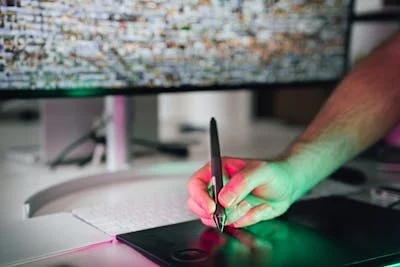In the world of digital art and graphic design, the way we edit images can significantly affect the quality and creativity of our work. One innovative technique gaining popularity is called “basdalm separation on images.” This method involves breaking down an image into smaller layers, allowing artists and designers to focus on specific elements such as colors, textures, or shapes. By using this technique, individuals can enhance their creative process, streamline their editing, and produce stunning visuals.
Basdalm separation makes it easier to adjust various aspects of an image without altering the entire piece. For instance, a designer can change the color of a layer while keeping the texture and shape intact. This control over individual elements allows for a more precise and thoughtful approach to image manipulation, leading to higher-quality results. Whether you’re a professional designer or a hobbyist, understanding and utilizing this technique can elevate your digital artwork.
The Process of Basdalm Separation
Breaking Down an Image into Layers
The first step in basdalm separation is to divide a complete image into smaller layers. Each layer can represent different features, such as colors, textures, or shapes. For example, if you have a picture of a sunset, one layer might hold the sky’s colors, while another captures the clouds and their textures. This breakdown allows you to make targeted adjustments to specific parts of the image, making it easier to improve clarity and detail.
When you work with layers, you can focus on one part of the image at a time. This targeted approach prevents accidental changes to other parts of the image, resulting in a cleaner editing process. With the right tools, separating an image into layers can be done efficiently, allowing designers to spend more time creating and less time fixing mistakes.
Tools and Software for Layer Separation
To implement basdalm separation, graphic designers can use various software tools. Popular programs include Adobe Photoshop, GIMP, and Affinity Photo. Each of these tools offers features to help isolate layers and edit them individually. For example, Photoshop has a dedicated layer panel that makes it easy to see and manage different layers. GIMP, a free alternative, provides customizable layer options, while Affinity Photo also supports advanced layer manipulation.
Using these tools, users can separate layers based on colors, textures, or other characteristics. Each program has a unique interface, making it essential for users to explore and find the one that suits their needs best. There are numerous tutorials and online resources available to help beginners learn how to use these tools effectively.
Technical Aspects of Layer Separation
Understanding the technical aspects of basdalm separation is crucial for achieving successful results. Designers often begin by isolating colors, which allows them to adjust specific hues without affecting other parts of the image. Texture separation is another common method that enhances details, making images more visually appealing.
In some cases, users may need to combine multiple layers to create the desired effect. By controlling the opacity and blending modes of different layers, designers can create complex images that possess depth and detail. Mastering these techniques requires practice and patience but can lead to stunning results.

Applications and Benefits
Enhancing Image Clarity and Quality
One of the primary advantages of basdalm separation is its ability to improve image clarity and quality. By isolating various components, users can make targeted adjustments that enhance details. For instance, artists can refine their digital artwork by correcting issues such as poor color balance or blurriness. This method is particularly useful for projects requiring high-quality visuals, as it allows designers to focus on specific aspects that need improvement.
Furthermore, layer separation allows for selective edits. For example, if a designer wants to adjust only the color layer without affecting the texture, they can do so easily. This precision helps maintain the integrity of other elements in the image, resulting in a polished final product.
Streamlining the Editing Process
Basdalm separation also streamlines the editing process, making it faster and more efficient. By dividing an image into layers, users can work on individual components without disrupting the entire piece. This saves time, especially on complex projects where multiple adjustments are necessary.
The ability to edit non-destructively is another significant advantage. With layers, users can experiment with different effects and easily revert to the original image if needed. This flexibility allows designers to explore creative options without risking permanent changes, fostering a more innovative environment for digital art.
Challenges and Limitations
While basdalm separation offers many benefits, it also comes with challenges. Technical difficulties may arise, especially when working with high-resolution images. Separating layers can require significant computing power, which may slow down the process or even lead to crashes with less capable software.
Another challenge is the learning curve associated with mastering this technique. For beginners, understanding how to effectively use the necessary tools and software may take time and practice. However, with patience and the right resources, individuals can gradually become proficient in basdalm separation.
Conclusion
In summary, basdalm separation on images is a powerful technique that allows users to isolate and enhance different elements within an image. This innovative approach is beneficial for professionals in graphic design and digital art, providing greater control over edits and facilitating the creation of high-quality visuals. The potential applications extend beyond art, making it a valuable skill in fields such as digital forensics and marketing.
Despite some challenges, such as technical requirements and the learning curve, the advantages of this technique make it worthwhile for anyone interested in advanced image processing. As technology continues to evolve, staying updated on new tools and trends will help users maximize the benefits of basdalm separation. With ongoing practice and exploration, this technique can open up new possibilities for creative expression and data analysis.
FAQs
Q: What is basdalm separation on images?
A: Basdalm separation is a technique that divides an image into separate layers, allowing for targeted adjustments to elements like colors and textures.
Q: How does this technique improve image quality?
A: It enables precise edits to individual components, leading to clearer and sharper images with improved color balance and detail.
Q: What tools can I use for layer separation?
A: Common tools include Adobe Photoshop, GIMP, and Affinity Photo, which offer features for separating and editing layers.
Q: Is this technique suitable for beginners?
A: Yes, beginners can learn this technique with practice and available tutorials, although it may have a learning curve.
Q: What are the challenges of using this method?
A: Challenges may include technical difficulties with high-resolution images, time constraints for detailed projects, and a need for powerful computer hardware.























